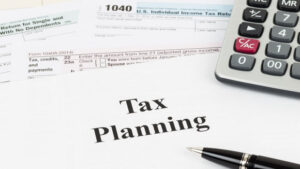Reduce your taxes or increase your refund for your next return by planning throughout the year. The IRS suggests that your first consideration should be going to IRS.gov for online tools that can help you file and pay taxes, find information about your accounts and get answers to tax questions.

Create or access your account at IRS.gov/account to:
- View your taxes owed, payments and payment plans.
- Make payments and apply for a payment plan.
- Access your tax records.
Gather and organize all of the previous year’s tax records, including:
- W-2 forms and pay stubs.
- Home mortgage payments and receipts from anything you can claim as an itemized deduction.
- Your vehicle mileage log if you intend to claim the vehicle as a business expense.
- Canceled checks from individual retirement account contributions and other deductions.
- Form 1099 from banks and other payments, such as unemployment compensation, dividends, a pension, and annuity and retirement plan distributions.
- Credit card statements.
- Medical bills you can deduct.
- Cellphone bills.
Keep the calendar in mind
Most qualifying tax deductions and tax credits for a given tax year must be expensed by Dec. 31 of the tax year. An exception is retirement plan contributions, which you can contribute to until April 15 — the filing and payment deadline.
Remember that most income is taxable, including unemployment income, interest received, income from the gig economy and digital assets. You should also check your individual Tax Identification Number to see whether it needs to be renewed.
Consider the possible tax implications of life-changing events like getting married, purchasing a home or making a career change — and unplanned life events that can have tax consequences, like separating from or divorcing your spouse.
Scan documents and keep them as PDF files to print out if you need them. Plan or make your estimated tax payments. What other steps can you take to help you plan for tax season? First, adjust your paycheck withholding so you can get a refund now as part of your regular paycheck rather than waiting to get it back as a tax refund. Adjust your W-4 to stop paying too much in income taxes.
Plenty of credits and deductions
- Sell stocks that are weighing down your portfolio so you can write off the loss on your taxes.
- Use tax filing software to help claim all the tax credits and deductions you may not know you qualify for.
- Contribute to traditional IRA, 401(k), 403(b) and other retirement accounts.
- Contribute to other tax-deductible accounts — Health Savings Accounts and/or Flexible Savings Accounts.
- Open and contribute to a 529 college savings plan.
- Start your own business and write off deductible expenses.
- Purchase a qualifying electric or hybrid vehicle for a tax credit.
- Educate yourself, a spouse or a dependent and claim an education tax credit.
- Donate to charity if you plan to itemize your deductions.
- Track your home mortgage insurance payments, plus state and local taxes.
- Check your pay stubs against your W-2 to ensure they add up — even employers can make mistakes.
If you’ve planned your taxes successfully enough to receive a small tax refund, invest in an educational savings account, an IRA or a basic savings account. Use the money to start preparing for next year’s taxes. The IRS recommends you keep all tax-related records for three years in case of an audit.
This is just a brief overview. You may have certain issues that make tax season more complicated, which gives you even more incentive to get started early by talking with a qualified tax preparer.
We welcome the opportunity to put our tax expertise to work for you. To learn more about how our firm can help advance your success, don’t hesitate to contact Kathy Corcoran at (302) 254-8240.
©2024

